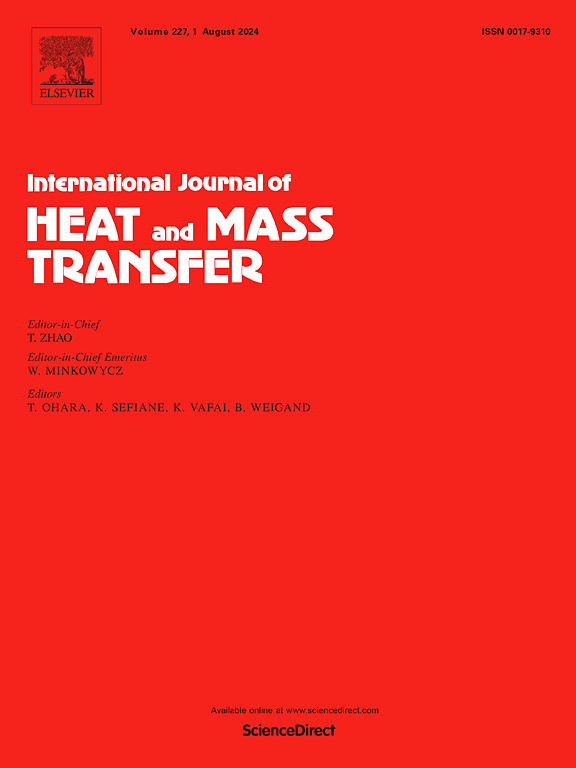低温脉动热管对绝热长度和匝数等几何参数的依赖
IF 5.8
2区 工程技术
Q1 ENGINEERING, MECHANICAL
International Journal of Heat and Mass Transfer
Pub Date : 2025-09-01
DOI:10.1016/j.ijheatmasstransfer.2025.127765
引用次数: 0
摘要
建立了以氮气为工质的脉动热管的二维CFD模型,研究了绝热段长度和匝数对脉动热管热水力特性和热性能的影响。单回路PHP的绝热截面分别为40 mm, 80 mm和200 mm,而匝数从单回路到两匝和三匝变化。填充率为50% %的PHP在蒸发器热负荷范围为0.5 W至4.0 W的情况下运行。在单回路PHP中,有效导热系数随着绝热长度的增加而增加,在200 mm单位内达到最大值6.3 kW/m-K。然而,在具有较长绝热段的热电厂中,蒸发器的平均温度随着热负荷的增加而迅速上升,有时会导致超过一定热负荷的运行不稳定。相反,随着转数的增加,有效导热系数减小,导致热负荷处理能力的提高(由于蒸发器平均温度的降低)。另一热性能参数热阻在单回路PHP中随着绝热长度的增加呈现相反的趋势,而随着转数的增加而减小,在三回路PHP中热阻最小为3.12 K/W,为4.0 W。对不同热负荷的无量纲卡门数进行了评估,说明了在不同绝热长度上驱动力和摩擦损失的综合影响。快速傅里叶变换(FFT)得到的主导频率主要取决于几何变量和热输入。典型的频率低于1赫兹。本文章由计算机程序翻译,如有差异,请以英文原文为准。
Cryogenic pulsating heat pipe – dependence on geometrical parameters like adiabatic length and number of turns
A two-dimensional CFD model has been developed to study the effect of adiabatic section length and number of turns on the thermo-hydraulic behaviour and the thermal performance of a pulsating heat pipe (PHP) using nitrogen as the working fluid. The adiabatic sections of the single-loop PHP are assigned as 40 mm, 80 mm, and 200 mm, while the number of turns has been varied from a single loop to two turns and three turns. The PHP with a 50 % fill ratio is operated with the evaporator heat load ranging from 0.5 W to 4.0 W. In a single loop PHP, the effective thermal conductivity increases with the adiabatic length, attaining a maximum value of 6.3 kW/m-K in the 200 mm unit. Nonetheless, the average evaporator temperature quickly escalates with the heat load in PHPs with longer adiabatic sections, sometimes leading to operational instability beyond a certain thermal load. On the contrary, with the increase in the number of turns, the effective thermal conductivity diminishes causing improvement in heat load handling capability (due to reduced average evaporator temperature). The other thermal performance parameter thermal resistance, exhibits an opposite trend with the rise in adiabatic length in the single-loop PHP, while it reduces with the increasing number of turns, showcasing a minimum thermal resistance of 3.12 K/W at 4.0 W in the three-turn PHP. Dimensionless Karman number evaluated for different heat loads illustrates a combined effect of driving force and frictional losses across various adiabatic lengths. The dominating frequency obtained from the Fast Fourier Transform (FFT) depends mainly on both the geometrical variables as well as thermal input. The typical frequency is below one Hertz.
求助全文
通过发布文献求助,成功后即可免费获取论文全文。
去求助
来源期刊
CiteScore
10.30
自引率
13.50%
发文量
1319
审稿时长
41 days
期刊介绍:
International Journal of Heat and Mass Transfer is the vehicle for the exchange of basic ideas in heat and mass transfer between research workers and engineers throughout the world. It focuses on both analytical and experimental research, with an emphasis on contributions which increase the basic understanding of transfer processes and their application to engineering problems.
Topics include:
-New methods of measuring and/or correlating transport-property data
-Energy engineering
-Environmental applications of heat and/or mass transfer

 求助内容:
求助内容: 应助结果提醒方式:
应助结果提醒方式:


